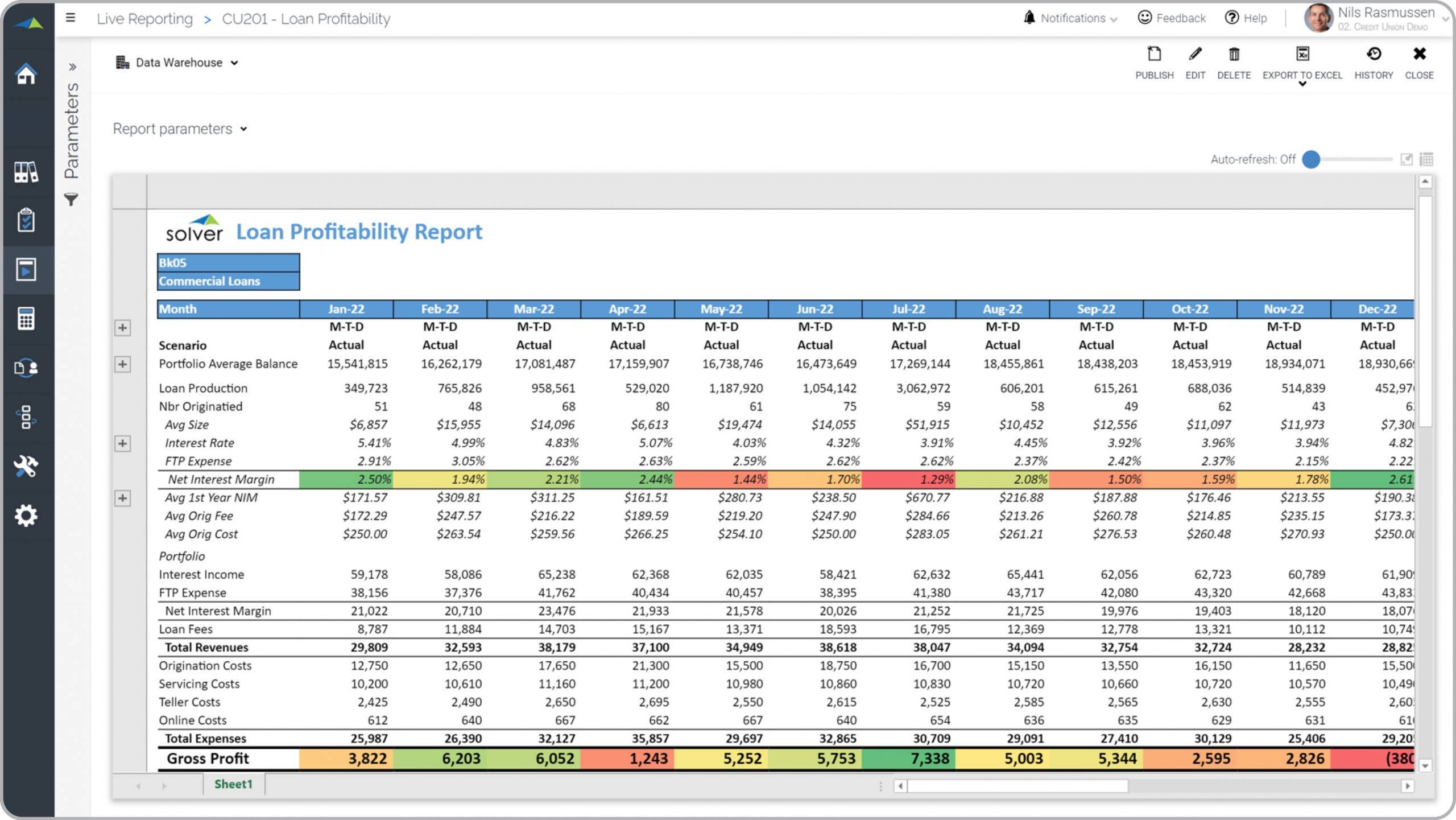Loan Profitability Trend Report for Credit Unions
What is
a
Loan Profitability Trend Report
? Loan Profitability Trend Reports are considered operational reports and are used by executives and loan managers to analyze monthly trends in loan KPIs. Some of the main functionality in this type of report is that it dynamically lists the months of the year across the columns and loan metrics down the rows with a Gross Profit Total at the bottom. Some of the key rows include: Portfolio average balance, Loan production, Nbr origination, Average size, Interest rate, FTP Expense, Net interest margin, Total Revenues, Origination costs, Servicing costs, Teller costs, Online costs, Total expenses, and Gross Profit. The green, yellow and red exception colors help highlight months with high/low profitability. You find an example of this type of report below.
Purpose of
Loan Profitability Trend Reports Credit Unions use Loan Profitability Trend Reports to give leaders an easily understandable format to analyze monthly trends in loan revenues, expenses and profitability. When used as part of good business practices in Loan- and Financial Planning & Analysis (FP&A) departments, a company can improve its net profit and related loan strategies, and it can reduce the chances that major exceptions or trends are not quickly discovered.
Example of a
Loan Profitability Trend Report Here is an example of a Loan Profitability Report with monthly trends in loan metrics and profitability. [caption id="" align="alignnone" width="2560"]
 Example of a Loan Profitability Trend Report for Credit Unions[/caption] You can find hundreds of additional examples
here
Who Uses This Type of
Report
? The typical users of this type of report are: Executives, branch managers, finance leaders, loan managers.
Other Reports Often Used in Conjunction with
Loan Profitability Trend Reports Progressive Loan- and Financial Planning & Analysis (FP&A) departments sometimes use several different Loan Profitability Reports, along with detailed loan reports, loan portfolio dashboards, KPI dashboards, branch benchmarking reports, annual budgets, profit & loss trend reports, balance sheets and other management and control tools.
Where Does the Data for Analysis Originate From? The Actual (historical transactions) data typically comes from loan management systems and enterprise resource planning (ERP) systems like: Microsoft Dynamics 365 (D365) Finance, Microsoft Dynamics 365 Business Central (D365 BC), Microsoft Dynamics AX, Microsoft Dynamics NAV, Microsoft Dynamics GP, Microsoft Dynamics SL, Sage Intacct, Sage 100, Sage 300, Sage 500, Sage X3, SAP Business One, SAP ByDesign, Acumatica, Netsuite and others. In analyses where budgets or forecasts are used, the planning data most often originates from in-house Excel spreadsheet models or from professional corporate performance management (CPM/EPM) solutions.
What Tools are Typically used for Reporting, Planning and Dashboards? Examples of business software used with the data and ERPs mentioned above are:
Example of a Loan Profitability Trend Report for Credit Unions[/caption] You can find hundreds of additional examples
here
Who Uses This Type of
Report
? The typical users of this type of report are: Executives, branch managers, finance leaders, loan managers.
Other Reports Often Used in Conjunction with
Loan Profitability Trend Reports Progressive Loan- and Financial Planning & Analysis (FP&A) departments sometimes use several different Loan Profitability Reports, along with detailed loan reports, loan portfolio dashboards, KPI dashboards, branch benchmarking reports, annual budgets, profit & loss trend reports, balance sheets and other management and control tools.
Where Does the Data for Analysis Originate From? The Actual (historical transactions) data typically comes from loan management systems and enterprise resource planning (ERP) systems like: Microsoft Dynamics 365 (D365) Finance, Microsoft Dynamics 365 Business Central (D365 BC), Microsoft Dynamics AX, Microsoft Dynamics NAV, Microsoft Dynamics GP, Microsoft Dynamics SL, Sage Intacct, Sage 100, Sage 300, Sage 500, Sage X3, SAP Business One, SAP ByDesign, Acumatica, Netsuite and others. In analyses where budgets or forecasts are used, the planning data most often originates from in-house Excel spreadsheet models or from professional corporate performance management (CPM/EPM) solutions.
What Tools are Typically used for Reporting, Planning and Dashboards? Examples of business software used with the data and ERPs mentioned above are:
- Native ERP report writers and query tools
- Spreadsheets (for example Microsoft Excel)
- Corporate Performance Management (CPM) tools (for example Solver)
- Dashboards (for example Microsoft Power BI and Tableau)
Corporate Performance Management (CPM) Cloud Solutions and More Examples
August 31, 2021
TAGS:
Reporting,
Solver,
report writer,
Microsoft,
template,
practice,
Acumatica,
Netsuite,
Finance,
credit union,
planning,
GP,
fintech,
Business Central,
excel,
ax,
forecast,
Budget,
Dynamics 365,
budgeting,
bank,
Cloud,
Software,
Tableau,
SAP,
example,
best,
Sage,
BC,
D365,
NAV,
Intacct,
financial institution,
CPM,
report,
branch,
SL,
Management,
dynamics,
Power BI,
loan,
loan profitability,
loan profitability trend report,
loan profitability report

